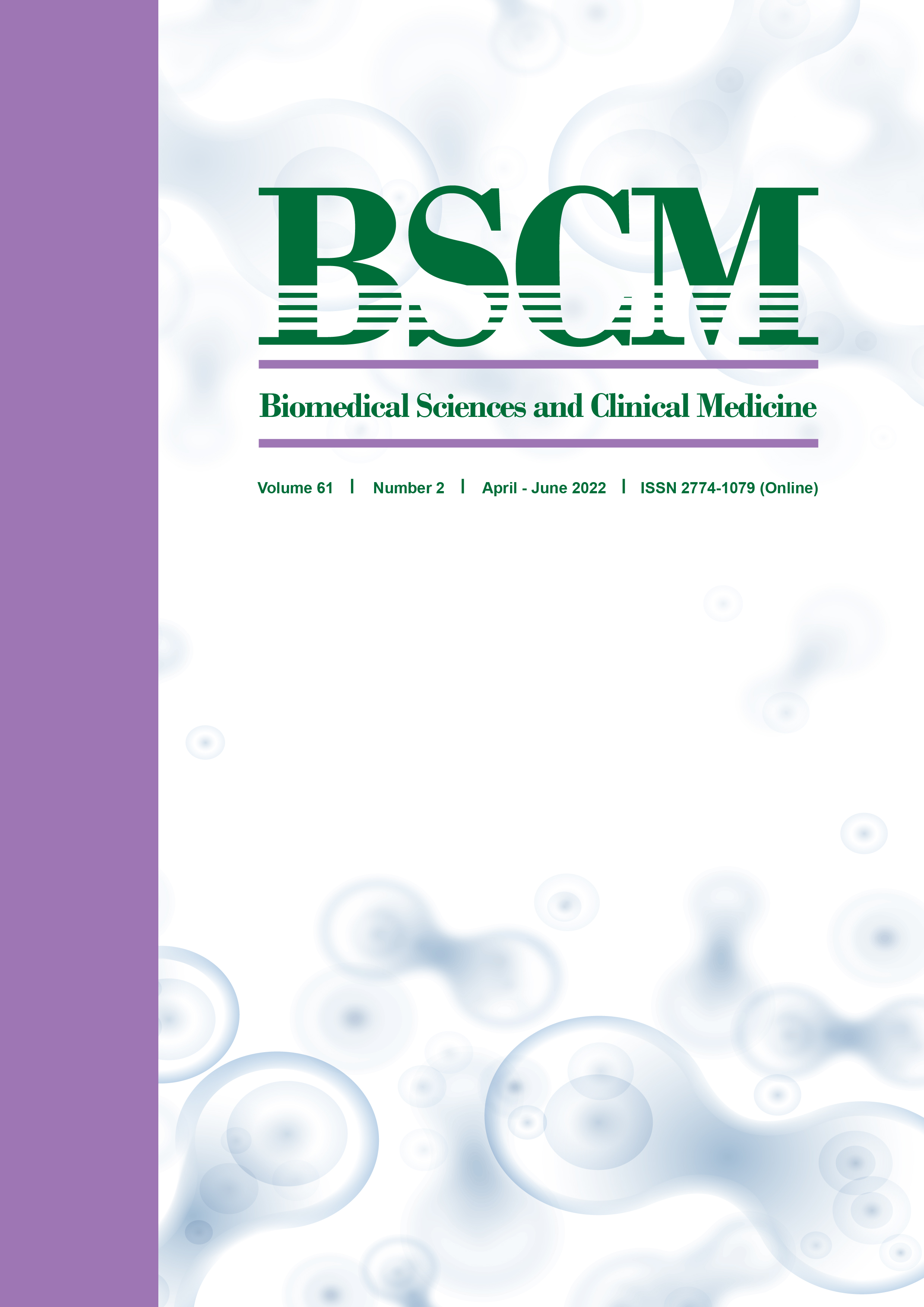G6PD Enzyme Activity in Newborns and Children: Reference Values by the Quantitative Colorimetric Method and a Comparison with the Fluorescent Spot Test
Keywords:
colorimetric method, G6PD, Glucose-6-phosphate dehydroge- nase, fluorescent spot test, G6PD enzyme activity, newborns, childrenAbstract
OBJECTIVE This study aimed to establish G6PD enzyme activity reference levels in newborns and children by the quantitative colorimetric method and to compare the results with the fluorescent spot test.
METHODS Leftover blood samples from newborns and children that were sent for G6PD measurement and tested by the fluorescent spot test at the Pediatric Laboratory, Faculty of Medicine, Chiang Mai University were further tested by the quantitative colorimetric method. The values were analyzed according to age group and the two methods were compared.
RESULTS There were 111 newborns (76 males, mean age 3.9±3.5 days) and 182 children (81 males, mean age 7.4±4.2 years). The mean G6PD enzyme activity levels in normal male and female newborns using the colorimetric method were 12.7±2.9 and 13.2±2.0 IU/g Hb, and in normal male and female children were 10.7±4.0 and 11.3±3.2 IU/g Hb, respectively. By the fluorescent spot test,
33 (11.3%), 7 (2.4%) and 253 (86.3%) samples were classified as G6PD deficient, intermediate-deficient and normal G6PD status, respectively. The sensitivity and specificity by the fluorescent spot test of males were 93.3, 98.4% and of female were 45.0, 99.1%, respectively.
CONCLUSIONS G6PD enzyme activity reference levels in newborns and children by a colorimetric method were established. The fluorescent spot test shows a good performance in males, but a lower performance in intermediate-deficient females. Therefore, females should be tested by the colorimetric method.
References
Ley B, Bancone G, von Seidlein L, Thriemer K, Richards JS, Domingo GJ, et al. Methods for the field evaluation of quantitative G6PD diagnostics: a review. Malar J. 2017;16:361.
Charoenkwan P, Tantiprabha W, Sirichotiyakul S, Phusua A, Sanguansermsri T. Prevalence and mo-lecular characterization of glucose-6-phosphate dehydrogenase deficiency in northern Thailand. Southeast Asian J Trop Med Public Health. 2014; 45:187-93.
Flatz G, Sringam S. Malaria and glucose-6-phos-phate dehydrogenase deficiency in Thailand. Lancet (London, England). 1963;2(7320):1248-50.
Beutler E, Yoshida A. Genetic variation of glucose- 6-phosphate dehydrogenase: a catalog and future prospects. Medicine (Baltimore). 1988;67:311-34.
Tinley KE, Loughlin AM, Jepson A, Barnett ED. Evaluation of a rapid qualitative enzyme chroma-tographic test for glucose-6-phosphate dehydro-genase deficiency. Am J Trop Med Hyg. 2010;82: 210-4.
von Fricken ME, Weppelmann TA, Eaton WT, Masse R, Beau de Rochars MV, Okech BA. Per-formance of the CareStart glucose-6-phosphate dehydrogenase (G6PD) rapid diagnostic test in Gressier, Haiti. Am J Trop Med Hyg. 2014;91:77-80.
World Health Organization Working Group. Glu-cose-6-phosphate dehydrogenase deficiency. Bull World Health Organ. 1989;67:601-11.
Espino FE, Bibit J-A, Sornillo JB, Tan A, von Seidle-in L, Ley B. Comparison of three screening test kits for G6PD enzyme deficiency: implications for its use in the radical cure of vivax malaria in remote and resource-poor areas in the Philippines. PLoS One. 2016;11:e0148172.
World Health Organization, editor Point-of-care G6PD testing to support safe use of primaquine for the treatment of vivax malaria. WHO Evidence Review Group meeting report; 2014.
World Health Organization. Guide to G6PD defi-ciency rapid diagnostic testing to support P. vivax radical cure. Geneva: World Health Organization; 2018.
Zhu A, Romero R, Petty HR. An enzymatic colori-metric assay for glucose-6-phosphate. Anal Bio-chem. 2011;419:266-70.
Domingo GJ, Satyagraha AW, Anvikar A, Baird K, Bancone G, Bansil P, et al. G6PD testing in support of treatment and elimination of malaria: recom-mendations for evaluation of G6PD tests. Malar J. 2013;12:391.
Alam MS, Kibria MG, Jahan N, Price RN, Ley B. Spectrophotometry assays to determine G6PD activity from Trinity Biotech and Pointe Scientific G6PD show good correlation. BMC Res Notes. 2018;11:855.
Konrad PN, Valentine W, Paglia D. Enzymatic ac-tivities and glutathione content of erythrocytes in the newborn: comparison with red cells of older normal subjects and those with comparable retic-ulocytosis. Acta Haematol. 1972;48:193-201.
Yang WC, Tai S, Hsu CL, Fu CM, Chou AK, Shao PL, et al. Reference levels for glucose-6-phosphate dehydrogenase enzyme activity in infants 7-90 days old in Taiwan. J Formos Med Assoc. 2020; 119(1 Pt 1):69-74.
Abdalla S, Phelan L, Hussein H. The value of screen-ing tests for glucose-6-phosphate dehydrogenase deficiency. Clin Lab Haematol. 1990;12:77-86.
Cappellini MD, Fiorelli G. Glucose-6-phosphate dehydrogenase deficiency. Lancet (London, Eng-land). 2008;371(9606):64-74.
Eziokwu AS, Angelini D. New Diagnosis of G6PD Deficiency Presenting as Severe Rhabdomyolysis. Cureus. 2018;10:e2387.
Frank JE. Diagnosis and management of G6PD de-ficiency. Am Fam Physician. 2005;72:1277-82.
Harcke SJ, Rizzolo D, Harcke HT. G6PD deficiency: An update. JAAPA-J AM ACAD PHYS. 2019;32:21-6.
Kotwal RS, Butler Jr FK, Murray CK, Hill GJ, Ray-field JC, Miles EA. Central retinal vein occlusion in an Army Ranger with glucose-6-phosphate dehy-drogenase deficiency. Mil Med. 2009;174:544-7.
Minucci A, Giardina B, Zuppi C, Capoluongo E. Glucose-6-phosphate dehydrogenase laboratory assay: How, when, and why? IUBMB Life. 2009;61: 27-34.
Ringelhahn B. A simple laboratory procedure for the recognition of A - (African type) G-6PD defi-ciency in acute haemolytic crisis. Clin Chim Acta. 1972;36:272-4.
van den Broek L, Heylen E, van den Akker M. Glu-cose-6-phosphate dehydrogenase deficiency: not exclusively in males. Clin Case Rep. 2016;4:1135-7.
Abdalla SH, Phelan L, Hussein HA. The value of screening tests for glucose-6-phosphate dehy-drogenase deficiency. Clin Lab Haematol. 1990;12: 77-86.
Kaplan M, Hammerman C. Glucose-6-phosphate dehydrogenase deficiency and severe neonatal hyperbilirubinemia: a complexity of interactions between genes and environment. Semin Fetal Neonatal Med. 2010;15:148-56.
Domingo GJ, Advani N, Satyagraha AW, Sibley CH, Rowley E, Kalnoky M, et al. Addressing the gender- knowledge gap in glucose-6-phosphate dehydro-genase deficiency: challenges and opportunities. International health. 2019;11:7-14.











